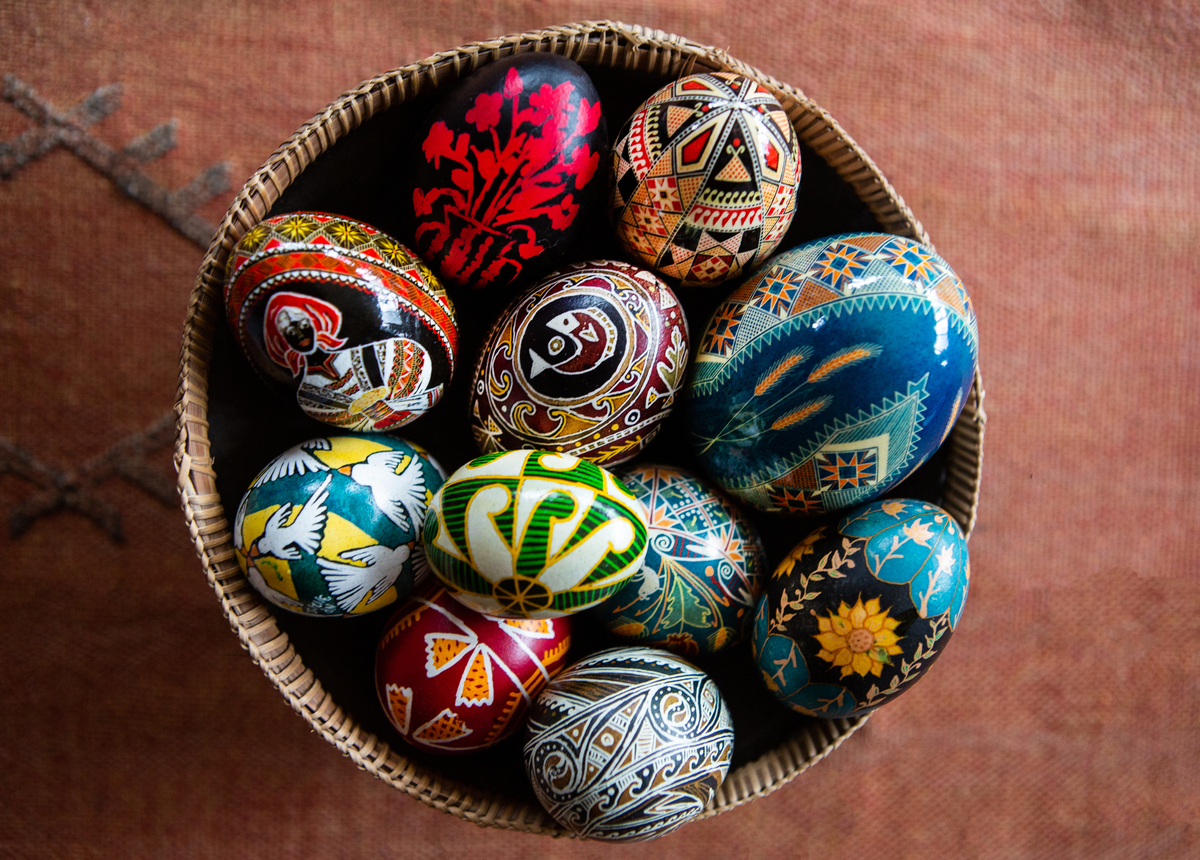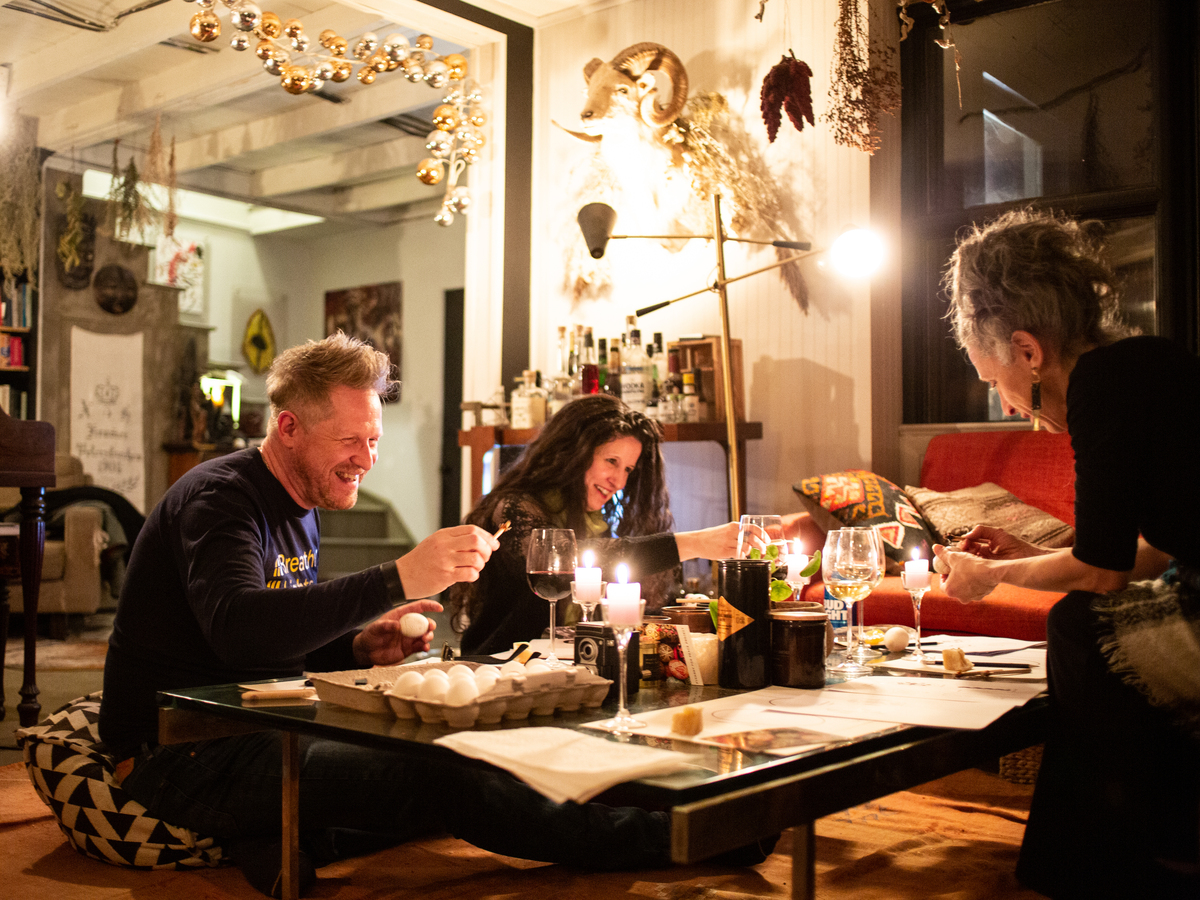The Art of Painting Eggs Is Called Pysanka What Country

Workshop participants learn to create pysanky, or Ukrainian-manner busy eggs, at a workshop in Troy, N.Y. on Mar. 21. Psyanky for Peace hide caption
toggle caption
Psyanky for Peace

Workshop participants larn to create pysanky, or Ukrainian-mode decorated eggs, at a workshop in Troy, N.Y. on Mar. 21.
Psyanky for Peace
Ukrainians take an aboriginal springtime tradition of intricately decorating eggs. This art form, chosen pysanky, has taken on special significant and urgency this year, due to the war in Ukraine. At present, experts and newcomers are sharing this art to raise money and practiced wishes for the Ukrainian people.
Sarah Bachinger is from Circular Lake, New York. She runs a group chosen Pysanky for Peace, which sends proceeds from workshops to humanitarian efforts in Ukraine.

A basket of pysanky fabricated by volunteers for Pysanky for Peace — from intricately decorated chicken eggs to goose eggs. Pysanky for Peace hide explanation
toggle caption
Pysanky for Peace

A handbasket of pysanky made by volunteers for Pysanky for Peace — from intricately decorated chicken eggs to goose eggs.
Pysanky for Peace
"The workshops I've been doing in my local area have garnered so much interest," Bachinger says. "People accept seen this type of work before, merely have never really looked into how it'southward washed in the history and culture backside information technology. So there'due south been a very big increased interest in how this piece of work is done and how it relates to Ukraine and Ukrainians."
Bachinger says that the workshops have brought people together — both folks who grew upward with this tradition, every bit she did as a Ukrainian-American, and those who are learning for the first time.
"The customs aspect that has kind of sprouted from this is only really beautiful," she observes. "Information technology'south just creating a space where people can come up together to the table and learn from each other, focus their intention on something good, and just relax and connect."

A pysanky-making gathering in Round Lake, Northward.Y. on Mar. three. Pysanky for Peace hide caption
toggle explanation
Pysanky for Peace

A pysanky-making gathering in Round Lake, N.Y. on Mar. 3.
Pysanky for Peace
Bachinger is as well organizing exhibitions of pysanky; the first opens at the Wenham Museum in Wenham, Mass on Apr. xvi. "Nosotros've received pysanky from Florida to Alaska," Bachinger enthuses.
Pysanky look similar they could have come direct out of a fairy tale. These eggs are gorgeously colored, from vivid pastels to regal red and black. It looks as if they've been meticulously painted with mesmerizing designs — swirls and curls, tiny geometric patterns, deer and flowers.
Merely they're not actually painted, Ukrainian-American ethnographer and artist Sofika Zielyk explains. You write the designs on the egg, using melted beeswax and a stylus, and so dip the egg in colored dye, repeating the procedure over and once more to get your desired result.

Artist and ethnographer Sofika Zielyk with her nascent installation of pysanky at the Ukrainian Constitute of America in New York on Apr. 1. Anastasia Tsioulcas/NPR hide caption
toggle caption
Anastasia Tsioulcas/NPR

Artist and ethnographer Sofika Zielyk with her nascent installation of pysanky at the Ukrainian Found of America in New York on Apr. 1.
Anastasia Tsioulcas/NPR
"Information technology'due south a wax resisting procedure, batik on an egg," Zielyk explains.
Zielyk is curating an installation of these eggs at the Ukrainian Institute of America in New York City. People are sending her pysanky from all over the earth, equally a symbol of hope against the Russian invasion. She says this tradition of decorating eggs goes back thousands of years.
"During the winter months, the days grew shorter and information technology was dark longer. People simply causeless that the sun god was angry with them and was leaving them. And so to bring him back," she continues, "they decided to give him a gift. And each year, around springtime, they had this special spring ritual."
Zielyk says that they believed that the egg had magical qualities.
"Number one, birds wing in the air," she says. "They're much closer to the sun than people are. People couldn't grab the birds, but they could go their eggs, and people idea when they held the egg in their hands, they could harness a little bit of the power of the sunday. Number two, the yolk reminded the people of the sun, and information technology was a way of paying tribute to him. And the third almost of import reason of all the rooster was the sunday god'southward chosen creature. He was the just creature that the sun god listened to, considering when the rooster crows, the sun comes out — and very often a rooster can come out of a chicken egg."

Recently arrived Ukrainian pysanky at the Ukrainian Institute of America in New York City on Apr. 1. Anastasia Tsioulcas/NPR hide caption
toggle caption
Anastasia Tsioulcas/NPR
The people would decorate eggs with symbols — a pino branch for fertility or a deer for force, for case — in hopes that the sun god would grant them their wishes. And when the area we now telephone call Ukraine became Christianized in the 9th and tenth centuries, people started assigning Christian ideas to this pagan springtime tradition.
"And so the ritual egg, which asked for the lord's day god to come up back, now became the symbol of Easter and Christ'south defeat over death, rising from death," Zielyk says.
Sarah Bachinger notes that as Ukrainians immigrated all over the world in the late 19th and early on 20th century, they carried this tradition with them — which may have saved the artform.
"During the Soviet era, under Stalin, he was trying to stop and eradicate any type of religious practices," Bachinger explains. "So pysanky were also banned considering they were then deeply connected with Easter. The diaspora kept the tradition alive."

Pysanky at the Ukrainian Institute of America in New York City. Kate Stremoukhova /Pysanky for Peace hide caption
toggle caption
Kate Stremoukhova /Pysanky for Peace

Pysanky at the Ukrainian Plant of America in New York Metropolis.
Kate Stremoukhova /Pysanky for Peace
These days, people ofttimes treasure their pysanky for years. Sofika Zielyk says that traditionally, nevertheless, they were ritually fabricated every spring, and so used equally talismans.
"They were blessed at Easter, so there were uses for them," she explains. "Eggshells were incorporated in cattle feed to make the cattle stronger. Eggshells were cached in the garden to have a better harvest. An egg with an eternity symbol was placed in beehives so that there would be continuous beloved. If a child died during the Easter season, a pysanka would be placed in the coffin, and so the child had something to play with. When a house was beingness congenital, a pysanka was put on the four corners to protect against evil spirits."
Zielyk says that when the end of the war comes, she will bring all the decorated eggs from her installation to her ancestral homeland.
"We're going, nosotros're going with hammers and nails...And these eggs are coming with us," she says firmly. "Symbolically, they will be dug into the fields. They volition be put in people'southward houses every bit they're being rebuilt. This will happen. This definitely will happen."
Just equally it was for her ancestors, these eggs will be part of Ukraine's rebirth.
Source: https://www.npr.org/2022/04/12/1091408208/these-intricately-decorated-eggs-are-raising-money-and-good-wishes-for-ukraine
0 Response to "The Art of Painting Eggs Is Called Pysanka What Country"
Postar um comentário